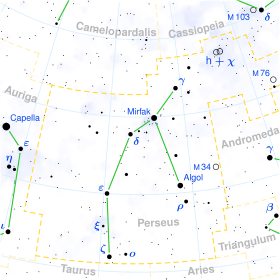Theta Persei
 | |
| Observation data Epoch J2000 Equinox J2000 | |
|---|---|
| Constellation | Perseus |
| Right ascension | 02h 44m 11.98704s[1] |
| Declination | +49° 13′ 42.4111″[1] |
| Apparent magnitude (V) | 4.16 / 10[2] |
| Characteristics | |
| Spectral type | F7 V + M1 V[3] |
| U−B color index | 0/0.99 |
| B−V color index | 0.49/1.48 |
| Astrometry | |
| Radial velocity (Rv) | +24.32[4] km/s |
| Proper motion (μ) | RA: +334.66[1] mas/yr Dec.: -89.99[1] mas/yr |
| Parallax (π) | 89.87 ± 0.22[1] mas |
| Distance | 36.29 ± 0.09 ly (11.13 ± 0.03 pc) |
| Absolute magnitude (MV) | 3.88[5] |
| Orbit[3] | |
| Primary | θ Per A |
| Companion | θ Per B |
| Period (P) | 2720 yr |
| Semi-major axis (a) | 22.289″ |
| Eccentricity (e) | 0.13 |
| Inclination (i) | 75.44° |
| Longitude of the node (Ω) | 128° |
| Periastron epoch (T) | B 1613 |
| Argument of periastron (ω) (secondary) | 100.64° |
| Details | |
| θ Per A | |
| Mass | 1.138 ± 0.010[6] M☉ |
| Radius | 1.319 ± 0.011[6] R☉ |
| Luminosity | 2.235 ± 0.040[6] L☉ |
| Temperature | 6,157 ± 37[6] K |
| Age | 4.0 ± 0.4[6] Gyr |
| θ Per B | |
| Mass | 0.521 ± 0.052[7] M☉ |
| Radius | 0.498 ± 0.017[7] R☉ |
| Temperature | 3685 ± 60[7] K |
| Other designations | |
| θ Per A: HR 799, HD 16895, FK5 93, GC 3277, PPM 45428, SAO 38288 | |
| θ Per B: 2MASS J02441025+4913540 | |
| Database references | |
| SIMBAD | θ Per |
| θ Per B | |
Theta Persei (Theta Per, θ Persei, θ Per) is a star system 37 light years away from Earth, in the constellation Perseus. The primary star is a yellowish dwarf (main sequence) star of spectral type F7V, which is somewhat larger and brighter than the Sun, but still within the range considered to have the potential for Earth-like planets. There is also a red dwarf companion of spectral type M1V, orbiting about 250 AU from the primary. The star's age is estimated to be 2.8 billion years but is certainly no less than 1.7 billion years and no greater than 3.9 billion years.[8]
Theta Persei is moving through the Galaxy at a speed of 30.5 km/s relative to the Sun. Its projected Galactic orbit carries it between 23,700 and 34,200 light years from the center of the Galaxy.[8]
Theta Persei came closest to the Sun 285,000 years ago when it had brightened to magnitude 2.99 from a distance of 21.7 light years.[8]
References
- 1 2 3 4 5 van Leeuwen, F. (2007), "Validation of the new Hipparcos reduction", Astronomy and Astrophysics, 474 (2): 653–664, arXiv:0708.1752, Bibcode:2007A&A...474..653V, doi:10.1051/0004-6361:20078357.
- ↑ "Sixth Catalog of Orbits of Visual Binary Stars". United States Naval Observatory. Retrieved 6 June 2017.
- 1 2 Boulé, Cory; Andrews, Kaitlyn; Penfield, Andrew; Puckette, Ian; Goodale, Keith A.; Harfenist, Steven A. (2017). "Determining Binary Star Orbits Using Kepler's Equation" (PDF). Journal of Double Star Observations. 13 (2): 189. Bibcode:2017JDSO...13..189B.
- ↑ Nidever, David L.; et al. (August 2002), "Radial Velocities for 889 Late-Type Stars", The Astrophysical Journal Supplement Series, 141 (2): 503–522, arXiv:astro-ph/0112477, Bibcode:2002ApJS..141..503N, doi:10.1086/340570.
- ↑ Holmberg, J.; et al. (July 2009), "The Geneva-Copenhagen survey of the solar neighbourhood. III. Improved distances, ages, and kinematics", Astronomy and Astrophysics, 501 (3): 941–947, arXiv:0811.3982, Bibcode:2009A&A...501..941H, doi:10.1051/0004-6361/200811191.
- 1 2 3 4 5 Boyajian, Tabetha S.; et al. (February 2012), "Stellar Diameters and Temperatures. I. Main-sequence A, F, and G Stars", The Astrophysical Journal, 746 (1): 101, arXiv:1112.3316, Bibcode:2012ApJ...746..101B, doi:10.1088/0004-637X/746/1/101 . See Table 10, 12.
- 1 2 3 Mann, Andrew W.; Feiden, Gregory A.; Gaidos, Eric; Boyajian, Tabetha; von Braun, Kaspar (2015). "How to Constrain Your M Dwarf: Measuring Effective Temperature, Bolometric Luminosity, Mass, and Radius". The Astrophysical Journal. 804 (1): 38. arXiv:1501.01635. Bibcode:2015ApJ...804...64M. doi:10.1088/0004-637X/804/1/64.
- 1 2 3 Theta Persei (HIP 12777) Archived 2013-01-02 at the Wayback Machine.
External links
- "Simbad Query Result". Simbad. Retrieved March 28, 2007.
- "Draft of SIM target stars". JPL. Archived from the original on February 2, 2007. Retrieved March 28, 2007.